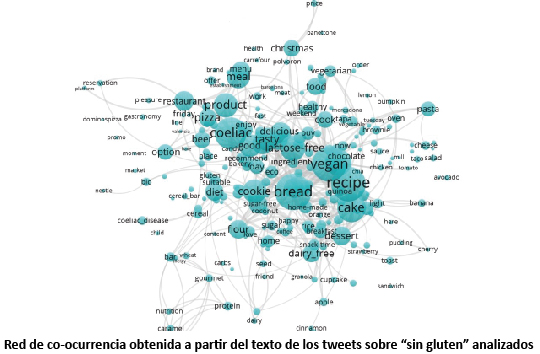
-
They have developed a method of analysis that automatically processes the text of a large number of Twitter messages and displays in summary form what is said on social networks about a topic.
-
Through co-occurrence networks, more than 16,000 Twitter messages have been analysed to find out what is most relevant for consumers of "gluten-free" products.
In recent years, an increase in consumer demand for gluten-free products has been observed, making them increasingly available on the market. For this reason, it is interesting to know what are their motivations for consuming this type of products, their opinions and what is most relevant for them.
Social networks have become one of the most popular ways to express opinions, ideas and values, which represents a potentially valuable tool for obtaining information that can be very useful in the study of the consumer.
The study carried out by researchers from IATA-CSIC (Amparo Tárrega, Laura Laguna, Susana Fiszman and Patricia Puerta) and the University of the Republic of Uruguay (Gastón Ares and Leticia Vidal), has shown that it is possible to know the content of tweets about "gluten-free" through co-occurrence networks to analyze what is being said about this topic. Co-occurrence networks are an analytical tool that shows in a quick and simple way in a two-dimensional map the most mentioned terms and how they interrelate between them, that is, they also allow to know the context in which they are mentioned.
The results showed that the most mentioned products were bread, cakes, cookies, beer and pizza. The analysis of the content of the tweets through the co-occurrence networks revealed that the users of Twitter share information about products, the social context of consumption, to recommend how to prepare them, where to get them, places to consume them and also to show what they eat, with whom or in what situations. In addition, terms were found that were generally positive, such as "enjoy", "delicious", "good", "tasty" or "happy".
The work, published in the magazine Food Quality and Preference, is part of the doctoral thesis that Patricia Puerta is carrying out at IATA on advanced techniques in the study of consumer response applied to the development and improvement of gluten-free products. He has also been selected to be included in the next edition of the Elsevier Research Selection e-newsletter.
References:
Puerta, P., Laguna, L., Vidal, L., Ares, G., Fiszman, S., & Tárrega, A. (2020). Co-occurrence networks of Twitter content after manual or automatic processing. A case-study on “gluten-free”. Food Quality and Preference, 86, 103993.

